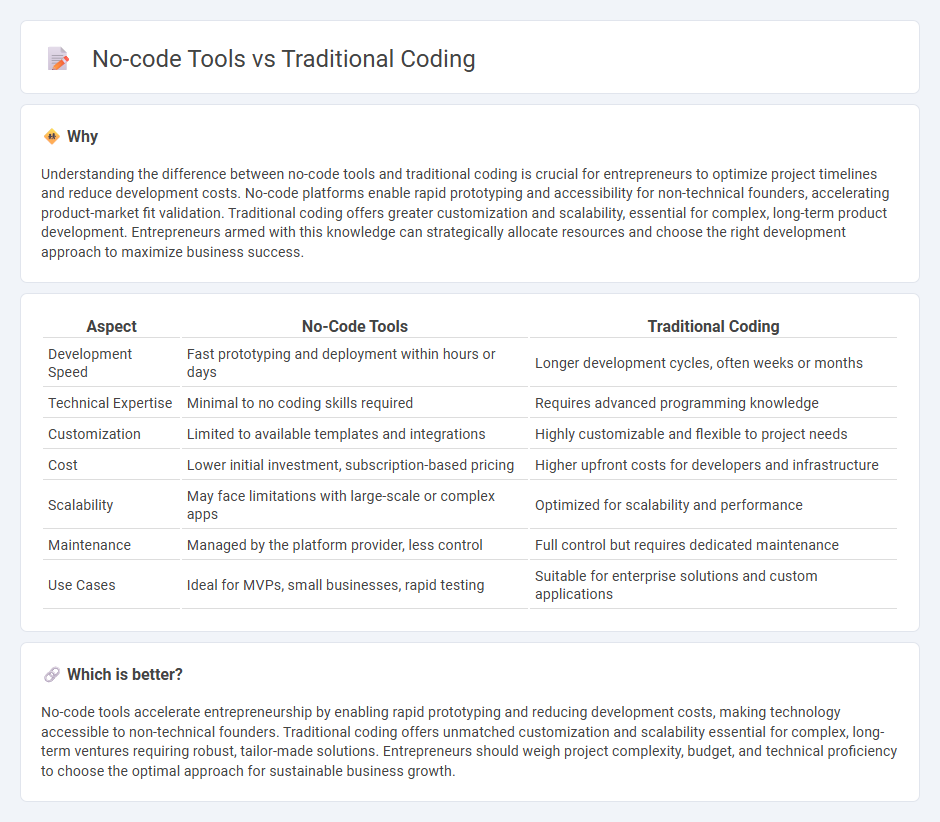
No-code tools empower entrepreneurs to build functional applications quickly without extensive programming knowledge, reducing development time and cost compared to traditional coding. Traditional coding offers deeper customization and scalability, essential for complex, large-scale projects requiring tailored solutions. Explore how choosing the right development approach can accelerate your entrepreneurial journey.
Why it is important
Understanding the difference between no-code tools and traditional coding is crucial for entrepreneurs to optimize project timelines and reduce development costs. No-code platforms enable rapid prototyping and accessibility for non-technical founders, accelerating product-market fit validation. Traditional coding offers greater customization and scalability, essential for complex, long-term product development. Entrepreneurs armed with this knowledge can strategically allocate resources and choose the right development approach to maximize business success.
Comparison Table
| Aspect | No-Code Tools | Traditional Coding |
|---|---|---|
| Development Speed | Fast prototyping and deployment within hours or days | Longer development cycles, often weeks or months |
| Technical Expertise | Minimal to no coding skills required | Requires advanced programming knowledge |
| Customization | Limited to available templates and integrations | Highly customizable and flexible to project needs |
| Cost | Lower initial investment, subscription-based pricing | Higher upfront costs for developers and infrastructure |
| Scalability | May face limitations with large-scale or complex apps | Optimized for scalability and performance |
| Maintenance | Managed by the platform provider, less control | Full control but requires dedicated maintenance |
| Use Cases | Ideal for MVPs, small businesses, rapid testing | Suitable for enterprise solutions and custom applications |
Which is better?
No-code tools accelerate entrepreneurship by enabling rapid prototyping and reducing development costs, making technology accessible to non-technical founders. Traditional coding offers unmatched customization and scalability essential for complex, long-term ventures requiring robust, tailor-made solutions. Entrepreneurs should weigh project complexity, budget, and technical proficiency to choose the optimal approach for sustainable business growth.
Connection
No-code tools and traditional coding intersect by enabling entrepreneurs to rapidly prototype and deploy applications without extensive programming knowledge while still allowing for custom development when deeper functionality is required. No-code platforms accelerate the entrepreneurial process by reducing time-to-market and lowering technical barriers, complementing traditional coding efforts in scalable and complex project stages. This synergy enhances innovation efficiency, empowering startups to iterate quickly and pivot based on market feedback effectively.
Key Terms
Development Speed
Traditional coding requires extensive programming knowledge and longer development cycles, often involving complex debugging and testing phases. No-code tools accelerate the development process by enabling users to create applications through visual interfaces and pre-built components without writing code. Explore how no-code platforms can revolutionize your project timelines and efficiency.
Customization
Traditional coding offers unparalleled customization by allowing developers to write specific, complex functions tailored to unique project requirements. No-code tools simplify the development process with drag-and-drop interfaces but often limit custom feature implementation and integration options. Explore how each approach impacts your project's flexibility and innovation potential to determine the best fit for your needs.
Technical Expertise
Traditional coding demands extensive technical expertise in programming languages such as Python, Java, or C++, allowing developers to create highly customized and scalable applications. No-code tools empower users with minimal or no coding knowledge to build functional software through intuitive interfaces and pre-built modules, significantly accelerating development timelines. Explore detailed comparisons and use cases to understand which approach best suits your project needs.
Source and External Links
No-code vs Traditional Coding: Which is Best for Your Business - Traditional coding is manually writing software code using languages like Java and Python, offering flexibility, full control, and scalability but requiring technical expertise and longer development time.
Low-code vs. traditional development: A comparison - Traditional coding involves writing code from scratch and delivers custom solutions with complete control over architecture and functionality, though it takes more time and effort compared to low-code approaches.
Low-Code vs Traditional Software Development - Traditional software development follows a structured process including requirement analysis, design, manual coding, testing, integration, deployment, and ongoing maintenance, demanding extensive technical skill and lengthy timelines.
 dowidth.com
dowidth.com